Best Practices > Details
Resilience Stories from Africa
31/12/2016

Resilience Stories from Africa
©@FAO
Today, 100 million people in Africa face acute hunger, and the continent’s population is expected to increase from 1.2 billion to 2.5 billion in 2050, with the percentage of people relying on agriculture for food and income rising to 70 percent.
In the past years, the scale and frequency of disasters and emergencies have been on the rise. Increasingly, natural disasters connected to climate change and human-made crises ravage the most vulnerable communities in Africa.
The
2016 FAO Webinar - Confronting drought in Africa’s drylands: opportunities for enhancing resilience analyzed current and future challenges to reducing vulnerability and increasing resilience in the drylands of Sub-Saharan Africa; and identified
promising interventions and strategies that can enhance the resilience of the millions of households that depend on traditional livelihood strategies, such as livestock-keeping and farming as well as putting in place safety nets. .png?sfvrsn=4e38e36b_1) Smallholder farmers, pastoralists, and fishermen are the key change agents in restoring and improving livelihoods and
communities. There must be decisive action taken to provide capacity for them to increase productivity and income through access to financial and technical assistance, skills training, and inclusive and innovative business models. Building self-reliant
smallholder farmers, pastoralists, and fishermen reinforce the capacities of vulnerable communities to bounce back from crises and unlocks the innovative potential of communities to find solutions to shocks and build a resilient society
Smallholder farmers, pastoralists, and fishermen are the key change agents in restoring and improving livelihoods and
communities. There must be decisive action taken to provide capacity for them to increase productivity and income through access to financial and technical assistance, skills training, and inclusive and innovative business models. Building self-reliant
smallholder farmers, pastoralists, and fishermen reinforce the capacities of vulnerable communities to bounce back from crises and unlocks the innovative potential of communities to find solutions to shocks and build a resilient society
The following stories from Africa showcases concrete resilience-building actions by African grassroots communities and smallholder farmers. 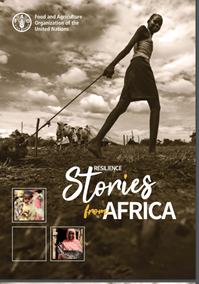
With about 60 percent of Africa’s population
living in rural areas and depending on agriculture and natural resources fortheir income, food, fuel and well-being, a number of concrete actions for building resilience must be immediately accelerated and advanced. These include working with farmers
and their communities to determine sustainable action they want to take and providing the capacity, access to financial and technical assistance, skills and training and inclusive and innovative business models to achieve them.
BOOSTING LOCAL FOOD PRODUCTION
FAO programs focus on providing materials while increasing people’s agricultural knowledge and skills, promoting self-reliance, and laying foundations for resilient livelihoods. FAO distributes
agricultural inputs, such as seeds, fertilizer, fishing equipment, livestock, fodder, and farm tools—all obtained locally where possible. The assistance provided is adjusted to the complexity of the situation and tailored to the livelihood of
the population, for example drought-resistant seeds and training in water conservation techniques for farmers.
Conserving and managing water 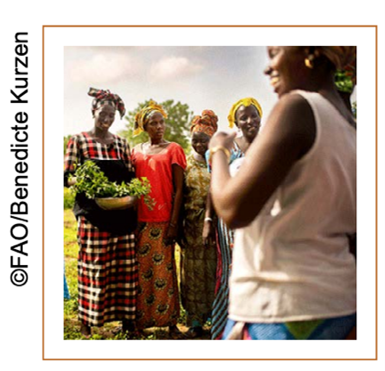
“Before the cisterns, we did not engage in agricultural activities and we did not have irrigation water, so we went to the market 12 km from here once a week and bought what we could. Today, we
have vegetable gardens and we are several women cultivating small plots”– Nene, mother of three, Senegal.
FAO set up rainwater retention systems in the Sahel, where rainfall is increasingly irregular, and wells, when they exist, are too far from those who have to use them. As part of its one million cistern initiative, FAO provides efficient
and sustainable management of water resources to build the resilience of vulnerable communities.
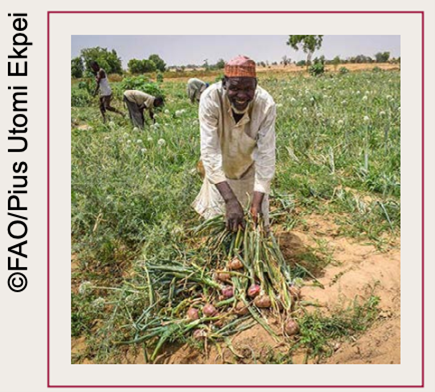 “The seed was another chance for me and my family to start over, my most important goal is to successfully send the younger ones to school.” – Bulama, Northeastern Nigeria.
“The seed was another chance for me and my family to start over, my most important goal is to successfully send the younger ones to school.” – Bulama, Northeastern Nigeria.
Bulama received seeds and fertilizer from FAO
under its dry season programme and began farming to sell surplus on the local market, after three years of unemployment and food aid. He is now able to stand on his own feet, buy a variety of food for his family and expand his farm. In 2018, about
78,000 small-scale farmers in northeastern Nigeria produced 198 099 tonnes of vegetables, 825 tonnes of maize and 9 402 tonnes of rice.
Adopting climate-smart irrigation techniques
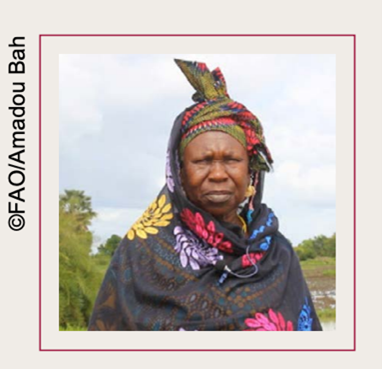
“In the past, the harvest could sustain households for 12 months if the rainy season was good, but now, with the impact of climate change, fewer people manage to consume their produce beyond six months.”– Manka, The Gambia.
Farmers in The Gambia are re-thinking agriculture to cope with the impacts of climate change, adopting drought-resistant and early maturing crops, creating irrigation strategies and adjusting the crop calendar. FAO is helping them implement small-scale
irrigation and drainage techniques to ensure access to water.
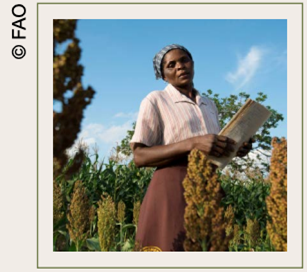 Fostering women’s leadership
Fostering women’s leadership
“Last season, although we got less rains, I managed to harvest enough to feed my big family and sell some
to send the children to school. Most villagers have run out of grain, but I still have enough grain to see me through to the next harvest.”– Calista, Zimbabwe.
In many communities, men are usually the ones who are given
the opportunity to attend training sessions, even though women do most of the work in the fields. FAO works to ensure that women get the skills and training they need, changing the gender dynamic on the ground. As lead farmer, Calista teaches climate-smart
farming practices to other smallholder farmers and has gained the respect of her community

Empowering small holder farmers as change agents to restore and improve their livelihoods in the face of growing weather extremes and conflict situations is key to building resilience.
Working together to build resilient small holder farmers will go a long way in helping vulnerable communities to bounce back from crises. Resilience building is at the heart of efforts to achieve zero hunger and poverty as well as the other interlinked global goals of the 2030 sustainable development agenda.
